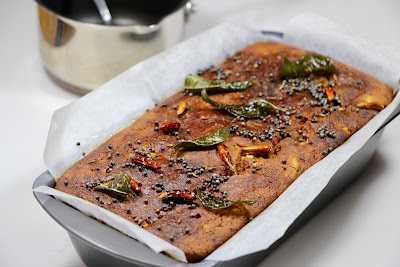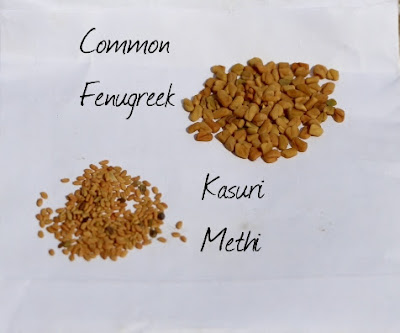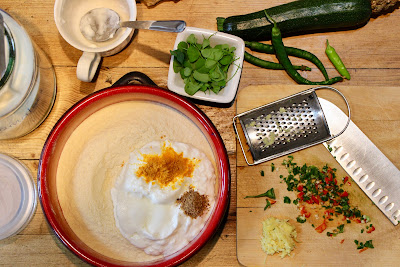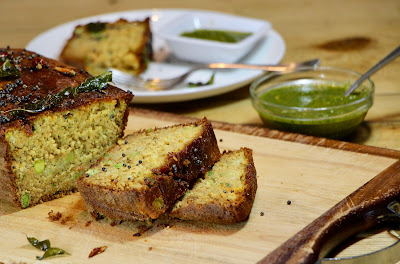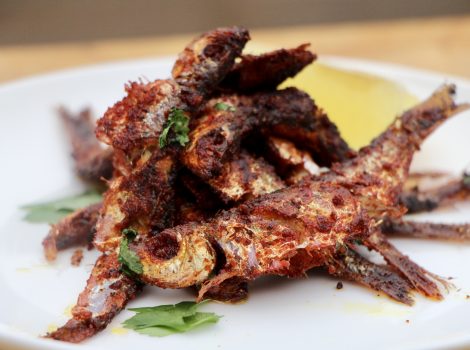Courgette & Fenugreek Bake (Cheats version of ‘Handvo’)
Firstly, I have to apologise, the Fenugreek spelling of Kasturi is incorrect! It is Kasuri. Name derives from a region in Pakistan, Kasur, close to the borders with Punjab region in India; where this Fenugreek herb originally grew and still grows in abundance, hence the name Kasuri Methi.
Why it is spelt and sold on the seed packet as Kasturi Methi, I couldn’t comment. I can only apologise for spelling it incorrectly in the past and will not be doing so in the future.
Kasuri Methi:
For some time, I have thought that there is a difference between Kasuri Methi and the Common Fenugreek. But could not challenge this fact, as I had never seen the seeds, plants or fresh leaves of this variety of Fenugreek only bought as a packet of dried Kasuri Methi leaves.
This year, managed to get hold of some Kasuri Methi seed packs, and when I poured some seeds out, I knew this Methi will be different in every way from growth to taste compared with the Common variety of Fenugreek.
I decided to experiment a little and grew these 2 varieties side by side:
Both germinated quickly, whilst Kasuri Methi stalks are thin and red; Common Fenugreek’s are thick and green.
As for the leaf structure, Kasuri Methi’s are lighter in shade and delicate to touch; Common Fenugreek are darker and much thicker in texture.
As for the ‘raw’ taste test, the Kasuri Methi, it has a surprisingly, lovely mellow taste, nothing compared to Common variety which is quite bitter to taste.
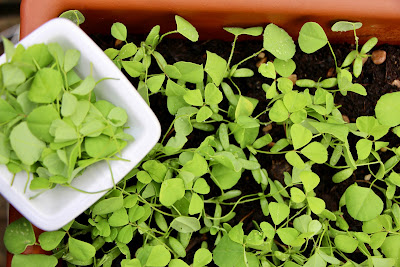 |
| Kasuri Methi |
The big ‘But’ is… it is the fresh leaves of Common Fenugreek that makes it into a well known Indian street food snack (Onion) Bhajiya.
So I will not rule out the Common variety any time soon.
This recipe I share with you, is a shortcut version of a Gujarati Dish called Hadvo:
*I am not going to use the traditional flour combination of Rice, 2 types of Gram and Wheat Flour.
*Or adding a commonly used vegetable Bottle Gourd (Dudi).
1 and 1/2 cup Semolina; 1 cup Set Yogurt; half cup water;
1 small Courgette :peeled ant diced; Small piece of Carrot: peeled and grated;
Handful of fresh Kasuri Methi leaves roughly chopped (if using common variety reduce amount by half); Handful of freshly shelled peas; 2 fresh chillies (1 green 1 red) finely chopped; A small piece of root Ginger: peeled and grated; 1/4 tsp each Garam Masala and Turmeric;1/2 tsp of fine Sea Salt ; 2 tbsp of Rape Seed Oil; 1tbsp Bicarbonate of Soda.
First prep the batter; into Semolina add Yogurt, Water, Oil,Ginger, Chillies, Garam Masala, Turmeric and Salt. Stir all together and should resemble a thick batter which easily falls away from the spoon (but not too runny).
Allow mixture to sit whilst you get a small loaf tin oiled and lined. Preheat the oven to 180˙C; place all vegetable and Fenugreek herb into the semolina batter and stir, until all vegetables are evenly distributed in the batter.
Finally add the soda and mix all vigoursly, you will see the mixture ‘frothing’ at this point gently pour into the tin and quickly place into the pre heated oven.
Bake for 40-50 mins or until a skewer, when inserted into the savoury bake, comes away clean. Remove from the oven immediately.
At this next stage tempering oil is added whilst the bake is still hot. Heat a small pan; add 1/2 teaspoon of brown mustard seeds; a few dried chilles and 1/4 tsp Cumin; allow to warm through; add 3 tbsp of Rape Seed Oil and allow to infuse bring up heat and add 4 or 5 fresh or dried Curry Leaves with a pinch of Asafoetida. Gently spoon this oil over the Courgette Bake and allow to cool completely in the tin.
Remove and slice into generous pieces and serve with a Coriander Chutney.
Enjoy x
